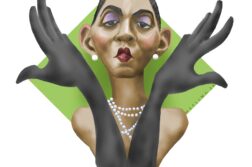 Hollywood Bohemians: Transgressive Sexuality and the Selling of the Movieland Dream
Hollywood Bohemians: Transgressive Sexuality and the Selling of the Movieland Dream
by Brett L. Abrams
McFarland and Company. 247 pages, $39.95
HOLLYWOOD BOHEMIANS is about homosexuals and, to a lesser extent, heterosexuals that Brett Abrams describes as “adulterous,” who were in the movie industry during the years 1917 to 1941. Abrams argues that not only did they contribute significantly to the construction of Hollywood’s image as the most racy and unconventional place in the country; they also helped to promote the movie industry by offering fans the vicarious thrill of culturally taboo behavior. They made America more tolerant, as well: fans were forced to examine their prejudices when they read in newspaper gossip columns or movie magazines such as Photoplay that their favorite celebrities engaged in unconventional behavior.

Abrams declares in his introduction that Hollywood Bohemians differs from previous scholarly writing about homosexuality in Hollywood, which insisted that “the people running Hollywood generally suppressed information about homosexuals.” In contrast, he promises to show that “images of adulterers, homosexuals, and cross dressers appeared in a much more positive light” in movies and novels about Hollywood. In addition to examining the era’s fan magazines, gossip columns, and long-forgotten films, Abrams discusses several little-known novels that were written between 1917 and 1950 and set in Hollywood. He also includes a number of photographs, notably a stunningly romantic picture of Randolph Scott lighting Cary Grant’s cigarette, the two men leaning toward each other intimately with the Pacific Ocean in the background.
Abrams’ arguments—particularly his insistence that Hollywood was not intent on hiding information about the homosexuality of stars, and that homosexuality was even presented in a “positive light”—are interesting but insufficiently nuanced and, in the face of much other evidence, ultimately not persuasive. He suggests that in the 1920’s and 30’s, fan magazines often featured articles such as the one on homosexual actor William Haines, about whom it was stated, “He has never been in love with any girl yet, and doesn’t intend to.” Abrams argues that the public clearly understood such statements to mean that the star was homosexual, and he claims that the fans’ recognition of this fact had no negative effect on an actor’s career.
However, if this were true, the “front marriage,” in which a gay person married a person of the opposite sex to pass as straight, and the “lavender tandem,” a marriage between a gay man and a lesbian so that both might pass as heterosexual, would not have been the common phenomenon that it was in Hollywood in the 1920’s and 30’s. For example, silent screen stars Edmund Lowe and Lilyan Tashman, both homosexual, deflected suspicion about their sexuality by marrying each other and then publicized their wedded “bliss” in fan magazines such as the June 1929 Photoplay, which featured them in an article entitled “How to Hold a Husband/Wife in Hollywood.” Similarly, lesbian silent film star Alla Nazimova lived in a lavender tandem with gay actor Charles Bryant, and, as Gavin Lambert shows in his illustrated biography Nazimova, the two posed often for publicity pictures, Nazimova sitting on Bryant’s lap or, in another photo, looking up at him in romantic adoration.
The bulk of evidence presented by other Hollywood historians demonstrates that if an actor’s homosexuality came to be known in this era, that actor was doomed. This happened to William Haines in 1936 when he and his lover Jimmy Shields were attacked as homosexuals by a mob in a Southern California beach town. According to William Mann in Wisecracker: The Life and Times of William Haines, the incident effectively ended Haines’ movie career. Haines’ longtime friend and fellow homosexual, director George Cukor, ceased to see him for many years because he feared for his own reputation.
Nor were Hollywood films of the 1930’s as gay-friendly as Abrams suggests. He barely mentions the Hollywood Production Code that was in full force by 1934 and forbade any reference to homosexuality in film; and while he presents some interesting examples of film images that got by the Hays Office of censorship in the latter part of the 1930’s, such as one of a queeny makeup artist in Something to Sing About (1937), he fails to analyze their satirical intent. He omits entirely any discussion of how far Hollywood would go to avoid getting into trouble with the censors. For example, Lillian Hellman’s 1934 Broadway play The Children’s Hour, in which two women are accused of being lesbians, was produced as a film in 1936, but the censors insisted that all suggestions of the lesbian theme be omitted, and that not even the title be used, because the public might have heard that The Children’s Hour touched on lesbianism. The movie title was thus changed to These Three, and the lesbian content of the play was replaced in the film by a heterosexual triangle.
Hollywood during the 1920’s and 30’s may well have been a place of wild homosexual revelry, as Abrams argues. Nevertheless, it seems quite clear that the studios were determined to keep that fact a secret from the fans.







